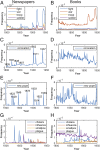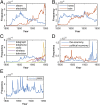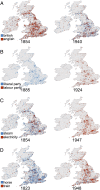Content analysis of 150 years of British periodicals
- PMID: 28069962
- PMCID: PMC5278459
- DOI: 10.1073/pnas.1606380114
Content analysis of 150 years of British periodicals
Abstract
Previous studies have shown that it is possible to detect macroscopic patterns of cultural change over periods of centuries by analyzing large textual time series, specifically digitized books. This method promises to empower scholars with a quantitative and data-driven tool to study culture and society, but its power has been limited by the use of data from books and simple analytics based essentially on word counts. This study addresses these problems by assembling a vast corpus of regional newspapers from the United Kingdom, incorporating very fine-grained geographical and temporal information that is not available for books. The corpus spans 150 years and is formed by millions of articles, representing 14% of all British regional outlets of the period. Simple content analysis of this corpus allowed us to detect specific events, like wars, epidemics, coronations, or conclaves, with high accuracy, whereas the use of more refined techniques from artificial intelligence enabled us to move beyond counting words by detecting references to named entities. These techniques allowed us to observe both a systematic underrepresentation and a steady increase of women in the news during the 20th century and the change of geographic focus for various concepts. We also estimate the dates when electricity overtook steam and trains overtook horses as a means of transportation, both around the year 1900, along with observing other cultural transitions. We believe that these data-driven approaches can complement the traditional method of close reading in detecting trends of continuity and change in historical corpora.
Keywords: Culturomics; artificial intelligence; computational history; data science; digital humanities.
Conflict of interest statement
F.N.T. is a team within the company FindMyPast. Its main role has been to provide part of the data and relative text.
Figures






References
-
- Reddy R, StClair G. 2001 The Million Book Digital Library Project. (Carnegie Mellon University, Piittsburgh). Available at www.rr.cs.cmu.edu/mbdl.htm. Accessed December 19, 2016.
-
- Gibbs FW, Cohen DJ. A conversation with data: Prospecting Victorian words and ideas. Vic Stud. 2011;54(1):69–77.
-
- Leetaru K. Culturomics 2.0: Forecasting large-scale human behavior using global news media tone in time and space. First Monday. 2011;16(9)
Publication types
LinkOut - more resources
Full Text Sources
Other Literature Sources

